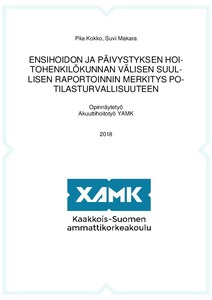| dc.contributor.author | Kokko, Piia | |
| dc.contributor.author | Makara, Suvi | |
| dc.date.accessioned | 2018-12-03T06:32:48Z | |
| dc.date.available | 2018-12-03T06:32:48Z | |
| dc.date.issued | 2018 | |
| dc.identifier.uri | URN:NBN:fi:amk-2018113019299 | |
| dc.identifier.uri | http://www.theseus.fi/handle/10024/155996 | |
| dc.description.abstract | Tämän opinnäytetyön tarkoituksena oli kuvata ensihoidon ja monitoimijapäivystyksen hoitajien välisen suullisen raportoinnin nykytilaa ja tunnistaa siihen liittyvät kehittämistarpeet. Opinnäytetyössä selvitettiin, miten hoitajien välinen suullinen potilasraportointi toteutuu ISBAR-tarkistuslistan mukaisesti sekä miten hoitohenkilökunnan mielestä suullinen potilasraportointi toimii ja mitä kehittämisideoita hoitajilla on suullisen potilasraportoinnin parantamiseksi.
Opinnäytetyö toteutettiin havainnointitutkimuksella sekä laadullisella kyselytutkimuksella keväällä 2018. Havainnointi tutkimuksella kuvattiin hoitohenkilökunnan välisiä raportointitilanteita ennakkoilmoituksen antamisen ja vastaanottamisen sekä potilaan luovuttamisen yhteydessä. Havainnoinnin pohjana käytettiin ISBAR-tarkistuslistaa. Lisäksi havainnoitiin sanattomien eleiden ja ilmeiden vaikutusta suulliseen potilasraportointiin. Havainnointitilanteita oli yhteensä 61. Sähköisellä kyselytutkimuksella selvitettiin suullisen potilasraportoinnin toteutumista hoitajien mielestä sekä hoitajien kehittämisehdotuksia suulliseen potilasraportointiin. Vastauksia saatiin yhteensä 59.
Havainnointitutkimuksen mukaan ISBAR-mallin mukainen suullinen potilasraportointi toteutuu puutteellisesti. Suullinen potilasraportointi eteni pääosin ISBAR-mallin mukaisesti, mutta viestintä ei ollut kaksisuuntaista ja kaikkia ISBAR:n osa-alueita ei raportoitu. Ennakkoilmoituksissa raportointi oli systemaattisempaa ja kaikki ISBAR:n osa-alueet toteutuivat paremmin kuin muissa raportointitilanteissa. Myös viestintä ennakkoilmoituksissa oli useammin kaksisuuntaista. Kyselytutkimuksen vastaukset täydensivät hyvin havainnointitutkimuksesta saatuja tuloksia ja vastauksista saatiin selittäviä tekijöitä ISBAR-mallin puutteelliselle toteutumiselle.
Johtopäätöksenä voidaan todeta, että ensihoidon ja monitoimijapäivystyksen välistä suullista potilasraportointia sekä siihen liittyviä toimintatapoja tulee kehittää. Suullisella potilasraportoinnilla ISBAR-mallin mukaisesti voidaan parantaa potilasturvallisuutta. | fi |
| dc.description.abstract | The aim of this thesis is to describe the present state of verbal communication between the emergency medical services and the emergency department and identify any areas in need of development. In the examination it was examine how the verbal communication whit regards to patient reports between nurses is implemented in accordance with the ISBAR checklist. The nursing staff`s opinions examined on how the reporting is performed as well as any ideas for improvement.
In this thesis was conducting to examined by means of observational research and a qualitative questionnaire survey in the spring of 2018. The observation goal was to describe with the communication among the nursing staff in relation with the giving and receiving a prior notice concerning patient admission. An ISBAR checklist was used as a basis of the observation. Furthermore, the effect of the wordless gestures and expressions on the communication of reporting was observed. Altogether the observation situations were 61. An electronic questionnaire survey was used to examine nurse’s opinions and the development proposals related to the verbal patient reporting. Altogether obtained were 59 answers.
According to the observational examination, the verbal patient reporting according to the ISBAR model is incomplete. Communication of patient reporting mainly ISBAR model but was neither reciprocal addressed the aspects of ISBAR reporting. As for the prior notices reporting was more systematic and all the aspects of ISBAR were better met than in other reporting situations. Also, communication in the prior notice situations was more often reciprocal. The answers of the questionnaire survey supplemented the results that were obtained from the observational examination and the answers provided factors for the defects in following of the ISBAR model.
As a conclusion the verbal patient reporting should be developed between emergency medical services and the emergency department. Verbal communication can be used to improve patient safety in accordance with the ISBAR model. | en |
| dc.language.iso | fin | |
| dc.publisher | Kaakkois-Suomen ammattikorkeakoulu | |
| dc.rights | All rights reserved | |
| dc.title | Ensihoidon ja päivystyksen hoitohenkilökunnan välisen suullisen raportoinnin merkitys potilasturvallisuuteen | fi |
| dc.type.ontasot | fi=Ylempi AMK-opinnäytetyö|sv=Högre YH-examensarbete|en=Master's thesis| | |
| dc.identifier.dscollection | 10024/154409 | |
| dc.organization | Kaakkois-Suomen ammattikorkeakoulu | |
| dc.contributor.organization | Kaakkois-Suomen ammattikorkeakoulu | |
| dc.subject.keyword | suullinen potilasraportointi | |
| dc.subject.keyword | ISBAR | |
| dc.subject.keyword | potilasturvallisuus | |
| dc.subject.degreeprogram | fi=Ensihoito ja akuutti hoitotyö|sv=Första- och akutvård|en=Emergency and Acute Care| | |
| dc.subject.discipline | Akuutti hoitotyö, (ylempi amk) | |
